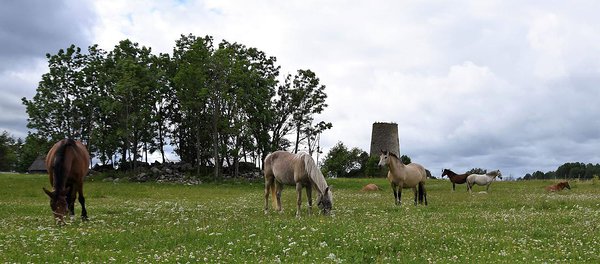Estonian Native horses have grown out of the Northern Forest Horses and have retained many attributes of their wild ancestors. Aside from prehistoric markings like dorsal and shoulder stripes, the Estonian Native has also inherited remarkable vitality and resilience to survive and thrive in the harsh northern climate.
The oldest written mention of the Estonian Native horse comes from the 11th century and there are records of many horses being exported in the 12th-13th century by merchants of Novgorod. In the 13th century, the breed was used as a warhorse in the battles across Estonia and Livonia. Czar Peter the First had a very high opinion of the breed and as such, even more horses were exported to Russia.
In peace times, the horses were mainly used for agricultural work, praised for their strength, endurance and easy-going, undemanding nature.
As many horses were lost in the wars, purposeful breeding of the Estonian Native was called for at the end of the First World War.
The studbook was found in the city of Haapsalu in 1921.
Since the aboriginal Estonian Native was relatively small, there was a desire to increase the strength, weight and height of the breed. For this purpose 13 Finnhorse stallions were exported from 1921-1938. From these stallions, the most prominent bloodline founders were Vuhti 136E, Taru 149E and Lari 23E. From the local aboriginal stallions, the bloodlines of Ahti 228E, Raspel 70E, Taube 60E and Eni 8E are still in use.
Characteristics
Similar to wild horses, the Estonian Native has survived the natural selection by staying small, alert, agile and robust. The horses are praised for their health and longevity.
The pureblood Estonian Native is a pony-sized pacer-type horse.
The average measurement (in cm):
Stallions - height at withers 142, oblique body length 147, chest girth 178, cannon bone girth 19.5
Mares: 141, 149, 182 and 19 respectively
Well-proportioned head with a wide forehead, a lively eye and a wide, muscular jaw.
Relatively short muscular neck with a thick mane.
The medium-length withers are low-set.
The back is mostly short, wide and straight. Loin is short, wide and strong.
The croup is plump and well-rounded, with an average length and width. The tail is low-set and thick.
The chest is wide and deep, followed by curved ribs and a capacious stomach.
The legs are short, properly set and distinguished by firmness and cleanness with strong tendons and joints. The hoofs are regular with hard ash-colored coronet.
Rare defects to look out for – irregular stand, soft or concave back.
The Estonian Native comes in a large variety of colours: sorrel, chestnut, black, grey, bay, dun, buckskin and cremello/perlino. Common aboriginal tokens are the dorsal stripe and transversed shoulder stripe.
The gait is typically wide and active, but there have been cases of dishing and paddling.
Why choose an Estonian Native?
There are many reasons to love this versatile breed. The Estonian Native horse is ideal for riding schools, on tourist rides; as a children’s pony or a family favourite.
They have a charmingly active and cheerful character, while also being calm and pragmatic. With an easy, yet energetic temperament, the breed is very pleasant in contrast to pretentious warmbloods and the indifference of large draft horses.
The horses are remarkably low-maintenance. The breed is well-adjusted to thrive on pastures by forage alone, except during winter times when hay and shelter would be needed.
They have good fodder utilisation and do not require special feeds.
Their size and versatility of use. Estonian Native range from mid-size ponies to small horses which can be ridden by both children and adults.
Most Estonian Native horses have strong legs and incredible pulling strength for their size. They can perform well in many disciplines from carriage driving to eventing.
Robustness and longevity. Usual life span is between 20-30 years.
***
The Estonian Native horse breed has been listed as one of the world’s endangered species by the Estonian Government and the Food and Agriculture Organization of the UN.
As of May 2024, there are ~2700 Estonian Native horses in the world, most of them in Estonia.
More info about this rare breed in Wikipedia
